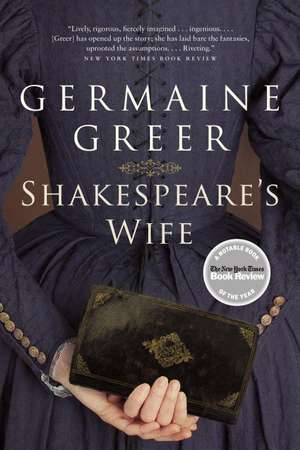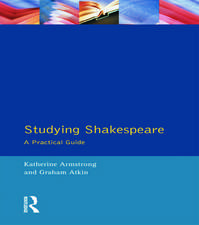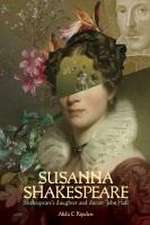Shakespeare's Wife
Autor Germaine Greeren Limba Engleză Paperback – 31 iul 2009
A polemical, ground-breaking study of Elizabethan England that reclaims Ann Hathaway’s rightful place in history.
Little is known about the wife of the world’s most famous playwright; a great deal, none of it complimentary, has been assumed. The omission of her name from Shakespeare’s will has been interpreted as evidence that she was nothing more than an unfortunate mistake from which Shakespeare did well to distance himself.
Yet Shakespeare is above all the poet of marriage. Before him, there were few comedies or tragedies about wooing or wedding. And yet he explored the sacrament in all its aspects, spiritual, psychological, sexual, sociological, and was the creator of some of the most tenacious and intelligent heroines in English literature. Is it possible, therefore, that Ann, who has been mocked and vilified by scholars for centuries, was the inspiration?
Until now, there has been no serious critical scholarship devoted to the life and career of the farmer’s daughter who married England’s greatest poet. Part biography, part history, Shakespeare’s Wife is a fascinating reconstruction of Ann’s life, and an illuminating look at the daily lives of Elizabethan women, from their working routines to the rituals of courtship and the minutiae of married life. In this thoroughly researched and controversial book, Greer steps off the well-trodden paths of orthodoxy, asks new questions, and begins to right the wrongs done to Ann Shakespeare.
From the Hardcover edition.
| Toate formatele și edițiile | Preț | Express |
|---|---|---|
| Paperback (2) | 80.45 lei 3-5 săpt. | +38.00 lei 5-11 zile |
| Bloomsbury Publishing – 31 aug 2008 | 80.45 lei 3-5 săpt. | +38.00 lei 5-11 zile |
| HarperCollins Publishers – 16 mar 2009 | 94.82 lei 3-5 săpt. |
Preț: 120.25 lei
Nou
Puncte Express: 180
Preț estimativ în valută:
23.01€ • 23.96$ • 19.45£
23.01€ • 23.96$ • 19.45£
Carte indisponibilă temporar
Doresc să fiu notificat când acest titlu va fi disponibil:
Se trimite...
Preluare comenzi: 021 569.72.76
Specificații
ISBN-13: 9780771035838
ISBN-10: 0771035837
Pagini: 416
Dimensiuni: 390 x 390 x 594 mm
Greutate: 0.45 kg
Editura: Emblem Editions
ISBN-10: 0771035837
Pagini: 416
Dimensiuni: 390 x 390 x 594 mm
Greutate: 0.45 kg
Editura: Emblem Editions
Notă biografică
Germaine Greer is a writer, academic, and critic whose bestselling books include The Female Eunuch and The Whole Woman. She gained her Ph.D. from the University of Cambridge in 1967 with a thesis on Shakespeare’s early comedies and has taught Shakespeare at universities in Australia, Britain, and the United States. She lives in northwest Essex, England.
From the Hardcover edition.
From the Hardcover edition.
Extras
Chapter One
Introducing the extensive and reputable family of Hathaway alias Gardner of Shottery together with the curious fact that one of their kinsmen was a successful playwright for the Admiral's Men
Shakespeare's wife was identified as long ago as 1709, when Nicholas Rowe informed the readers of his edition of the plays: 'His wife was the daughter of one Hathaway, said to have been a substantial yeoman in the neighbourhood of Stratford." There were many Hathaways within a day's ride of Stratford. Hathaways farmed in Bishopton and Shottery in Warwickshire, and in Horton, Bledington, Kingscote and surrounding districts in neighbouring Gloucestershire. There were also tradesmen called Hathaway in London, Banbury and Oxford, and one or two claimed the rank of gentleman. The Hathaway horde was so numerous in fact that the Shottery family into which Ann was born used a distinguishing alias. They were known mostly as Hathaway alias Gardner, and sometimes as just plain Hathaway or just plain Gardner.
In the medieval period such aliases served to distinguish between people with the same surname by specifying the region or town they came from or the trade they followed. Perhaps an earlier Hathaway had indeed been a gardener. Sometimes, when there was no male heir, a female descendant's husband might inherit on condition that he assumed her family name as an alias. The point of aliases is still being disputed by genealogists; although during Ann Shakespeare's lifetime the use of aliases became less consistent, it was a generation or two before it faded out altogether. We know that Ann's grandfather John Hathaway was already using the alias, so it is not something we are likely ever to unravel. For years nobody realised that the 'Jone Gardner of Shottery' who was buried in Holy Trinity churchyard in 1599 was the same person they had already identified as Ann Shakespeare's stepmother. In 1590 a 'Thomas Greene alias Shakespeare' was buried in Holy Trinity Church Stratford, sending historians off on a wild-goose chase for a woman called Greene giving birth to an illegitimate Shakespeare, or vice versa, for the alias was occasionally used for de facto wives and to denote descent on the wrong side of the blanket.
The Christian name of the woman who married William Shakespeare in 1582 is as unstable as her surname. The only evidence that Richard Hathaway alias Gardner of Shottery had a daughter called Ann is a reference in his will to a daughter called Agnes. Scholars have demonstrated convincingly that in this period Agnes and Ann were simply treated as versions of the same name, pointing out dozens of examples where Agnes, pronounced 'Annis', gradually becomes 'Ann'. Richard Hathaway left a sheep to a great-niece he calls Agnes, though according to the parish record she was actually christened Annys; in 1600 she was buried as Ann. Theatre manager Philip Henslowe called his wife Agnes in his will but she was buried as Ann. Ann's brother Bartholomew called a daughter Annys, but she was buried as Ann. The curate William Gilbert alias Higgs who wrote Hathaway's will married Agnes Lyncian, but she was buried as Ann Gilbert. This is not simply serendipitous. Agnes was the name of a fourth-century virgin martyr of the kind whose lurid and preposterous adventures are the stuff of The Golden Legend, justly ridiculed by protestant reformers. Ann (or Hannah) was the solid biblical name of the Redeemer's grandmother. It is only to be expected that as protestantism gained hearts and minds Agnes would be silently driven out by Ann. We may accept that the child born Agnes Hathaway grew up to be Ann Shakespeare.
The brass plate set in the stone over her grave next to William's in the chancel of Holy Trinity Church Stratford tells us that Ann Shakespeare 'departed this life on the sixth day of August 1623 being of the age of 67 years'. We have no evidence to corroborate this information. If the funeral plate is correct she was born in 1556, eight years before her husband. Engravers do make mistakes; the figures 1 and 7 are easily confounded in the calligraphy of 1623, but as all Ann's family was baptised at Holy Trinity, where the registers began to be kept in obedience to the royal edict of 1558, we must conclude that she was born before the register began to be kept, and not afterwards. So 1556 it is.
Our best evidence that Agnes Hathaway alias Gardner of Shottery is the woman who married Will Shakespeare in 1582 is the will made in 1601 by her father's shepherd Thomas Whittington. Whittington is identified in Richard Hathaway's will: 'I owe unto Thomas Whittington my shepherd four pounds six shillings eight pence.' Twenty years on, when he made his will in 1601, Whittington identified Ann as Shakespeare's wife:
Item I give and bequeath unto the poor people of Stratford forty shillings that is in the hand of Ann Shakespeare wife unto Mr William Shakespeare and is due debt unto me being paid to mine executor by the said William Shakespeare or his assigns according to the true meaning of this my will.
The Hathaway family house is supposed to be the one that is now known as Ann Hathaway's Cottage, though indeed it was never hers. This twelve-roomed farmhouse, known to the Hathaway family, if not to the bardolatrous public, as Hewlands Farm, is built on stone foundations, of timber-framed wattle-and-daub. The oldest part of the dwelling, thought to date from the late fourteenth century, consists of a hall of two twelve-foot bays reaching to the timbered roof, constructed around two oaken crucks that are pinned together to form the peak of the roof Before the Great Rebuilding of the 1560s, all the members of the household would have slept in the hall, around an open fireplace from which the smoke escaped through an opening in the thatch.
Ann's paternal grandfather, John Hathaway alias Gardner, acquired the copyhold of Hewlands Farm in 1543 and it was probably he who modernised the house by installing stone fireplaces in each of the two bays of the hall, one eight feet across and the other eleven. The stone hearths were also the supports for stout oak bressemers supporting an upper floor which was divided into separate connecting rooms. On the ground floor, next to the hall, there was a kitchen with a huge domed bread-oven. A dairy or buttery has also survived. An east wing was added to the main building later, probably by Ann's brother, Bartholomew Hathaway.
From the Hardcover edition.
Introducing the extensive and reputable family of Hathaway alias Gardner of Shottery together with the curious fact that one of their kinsmen was a successful playwright for the Admiral's Men
Shakespeare's wife was identified as long ago as 1709, when Nicholas Rowe informed the readers of his edition of the plays: 'His wife was the daughter of one Hathaway, said to have been a substantial yeoman in the neighbourhood of Stratford." There were many Hathaways within a day's ride of Stratford. Hathaways farmed in Bishopton and Shottery in Warwickshire, and in Horton, Bledington, Kingscote and surrounding districts in neighbouring Gloucestershire. There were also tradesmen called Hathaway in London, Banbury and Oxford, and one or two claimed the rank of gentleman. The Hathaway horde was so numerous in fact that the Shottery family into which Ann was born used a distinguishing alias. They were known mostly as Hathaway alias Gardner, and sometimes as just plain Hathaway or just plain Gardner.
In the medieval period such aliases served to distinguish between people with the same surname by specifying the region or town they came from or the trade they followed. Perhaps an earlier Hathaway had indeed been a gardener. Sometimes, when there was no male heir, a female descendant's husband might inherit on condition that he assumed her family name as an alias. The point of aliases is still being disputed by genealogists; although during Ann Shakespeare's lifetime the use of aliases became less consistent, it was a generation or two before it faded out altogether. We know that Ann's grandfather John Hathaway was already using the alias, so it is not something we are likely ever to unravel. For years nobody realised that the 'Jone Gardner of Shottery' who was buried in Holy Trinity churchyard in 1599 was the same person they had already identified as Ann Shakespeare's stepmother. In 1590 a 'Thomas Greene alias Shakespeare' was buried in Holy Trinity Church Stratford, sending historians off on a wild-goose chase for a woman called Greene giving birth to an illegitimate Shakespeare, or vice versa, for the alias was occasionally used for de facto wives and to denote descent on the wrong side of the blanket.
The Christian name of the woman who married William Shakespeare in 1582 is as unstable as her surname. The only evidence that Richard Hathaway alias Gardner of Shottery had a daughter called Ann is a reference in his will to a daughter called Agnes. Scholars have demonstrated convincingly that in this period Agnes and Ann were simply treated as versions of the same name, pointing out dozens of examples where Agnes, pronounced 'Annis', gradually becomes 'Ann'. Richard Hathaway left a sheep to a great-niece he calls Agnes, though according to the parish record she was actually christened Annys; in 1600 she was buried as Ann. Theatre manager Philip Henslowe called his wife Agnes in his will but she was buried as Ann. Ann's brother Bartholomew called a daughter Annys, but she was buried as Ann. The curate William Gilbert alias Higgs who wrote Hathaway's will married Agnes Lyncian, but she was buried as Ann Gilbert. This is not simply serendipitous. Agnes was the name of a fourth-century virgin martyr of the kind whose lurid and preposterous adventures are the stuff of The Golden Legend, justly ridiculed by protestant reformers. Ann (or Hannah) was the solid biblical name of the Redeemer's grandmother. It is only to be expected that as protestantism gained hearts and minds Agnes would be silently driven out by Ann. We may accept that the child born Agnes Hathaway grew up to be Ann Shakespeare.
The brass plate set in the stone over her grave next to William's in the chancel of Holy Trinity Church Stratford tells us that Ann Shakespeare 'departed this life on the sixth day of August 1623 being of the age of 67 years'. We have no evidence to corroborate this information. If the funeral plate is correct she was born in 1556, eight years before her husband. Engravers do make mistakes; the figures 1 and 7 are easily confounded in the calligraphy of 1623, but as all Ann's family was baptised at Holy Trinity, where the registers began to be kept in obedience to the royal edict of 1558, we must conclude that she was born before the register began to be kept, and not afterwards. So 1556 it is.
Our best evidence that Agnes Hathaway alias Gardner of Shottery is the woman who married Will Shakespeare in 1582 is the will made in 1601 by her father's shepherd Thomas Whittington. Whittington is identified in Richard Hathaway's will: 'I owe unto Thomas Whittington my shepherd four pounds six shillings eight pence.' Twenty years on, when he made his will in 1601, Whittington identified Ann as Shakespeare's wife:
Item I give and bequeath unto the poor people of Stratford forty shillings that is in the hand of Ann Shakespeare wife unto Mr William Shakespeare and is due debt unto me being paid to mine executor by the said William Shakespeare or his assigns according to the true meaning of this my will.
The Hathaway family house is supposed to be the one that is now known as Ann Hathaway's Cottage, though indeed it was never hers. This twelve-roomed farmhouse, known to the Hathaway family, if not to the bardolatrous public, as Hewlands Farm, is built on stone foundations, of timber-framed wattle-and-daub. The oldest part of the dwelling, thought to date from the late fourteenth century, consists of a hall of two twelve-foot bays reaching to the timbered roof, constructed around two oaken crucks that are pinned together to form the peak of the roof Before the Great Rebuilding of the 1560s, all the members of the household would have slept in the hall, around an open fireplace from which the smoke escaped through an opening in the thatch.
Ann's paternal grandfather, John Hathaway alias Gardner, acquired the copyhold of Hewlands Farm in 1543 and it was probably he who modernised the house by installing stone fireplaces in each of the two bays of the hall, one eight feet across and the other eleven. The stone hearths were also the supports for stout oak bressemers supporting an upper floor which was divided into separate connecting rooms. On the ground floor, next to the hall, there was a kitchen with a huge domed bread-oven. A dairy or buttery has also survived. An east wing was added to the main building later, probably by Ann's brother, Bartholomew Hathaway.
From the Hardcover edition.
Recenzii
“Lively, rigorous, fiercely imagined . . . ingenious. . . . [Greer] has opened up the story; she has laid bare the fantasies, uprooted the assumptions. . . . Riveting.”
— New York Times Book Review
“A riveting read. . . . Not only Greer’s scholarship but her sympathy and her imagination are fully engaged.”
— Victoria Glendinning
“Fascinating. . . . [Greer] re-creates in lavish detail the material realities of women’s lives in 16th century England.”
— Entertainment Weekly
From the Hardcover edition.
— New York Times Book Review
“A riveting read. . . . Not only Greer’s scholarship but her sympathy and her imagination are fully engaged.”
— Victoria Glendinning
“Fascinating. . . . [Greer] re-creates in lavish detail the material realities of women’s lives in 16th century England.”
— Entertainment Weekly
From the Hardcover edition.
Caracteristici
Shakespeare's Wife sold 8,000 copies in hardback and trade paperback, and will be a strong outdoor presence this autumn, with a major consumer campaign to ensure it hits the bestseller charts.
Descriere
Descriere de la o altă ediție sau format:
A biography of Ann Hathaway and a social history of Shakespeare's time by the redoubtable Germaine Greer




















